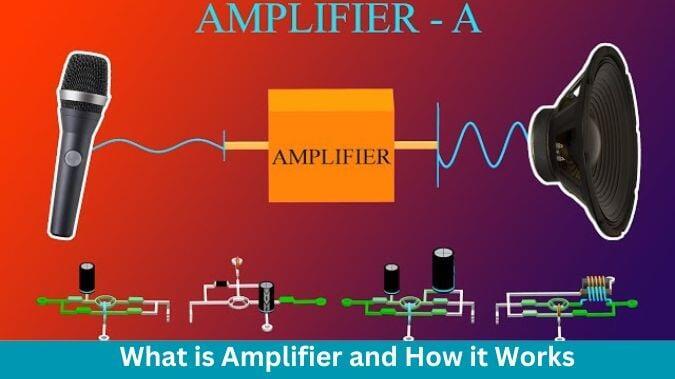What is an Amplifier?
An amplifier is an electronic device that increases the amplitude of a signal, which may be a voltage, current, or power signal. An amplifier plays an important role in audio systems, communication systems, and in various electronic devices where signal strength needs to be enhanced.
Amplifier Circuit
An amplifier circuit is composed of electronic components designed to increase the amplitude of an input signal, such as voltage, current, or power. The circuit involves components like transistors, resistors, and capacitors (for setting gain, frequency response, and stability),a power supply, and a feedback network (used for gain control, linearity, and bandwidth tuning).
Types of Amplifier
Amplifiers are classified into various types based on their design, function, and application.
1. Voltage Amplifier
This amplifier is used for the amplification of the input voltage. They have high input impedance and moderate output impedance. Mostly, these amplifiers are used in audio systems, sensor signal conditioning, and op-amp circuits.
2. Current Amplifier
Current amplifiers are used to increase the current of the input signal. It has features like low input impedance and high output current. These amplifiers are used in motor controllers and actuator drivers.
3. Power Amplifier
These types of amplifiers have features like driving high power loads with minimal signal distortion, which is used to boost both voltage and current to deliver high power output. This type of amplifier is used in loudspeakers and RF transmission systems.
4. Operational Amplifier
Operational amplifiers have extremely high gain and differential inputs. This is a versatile IC that can be configured as a voltage, current, or differential amplifier. It is used in signal processing, analog computation, filters, and control systems.
5. Differential Amplifier
This type of amplifier has high common-mode noise rejection, which is used to amplify the difference between two input signals. They are used in sensor interfaces, instrumentation, and op-amp input stages.
6. RF amplifier
This amplifier is used for amplifying high-frequency signals (MHz to GHz). This amplifier is optimized for bandwidth and noise performance and used in radio transmitters, receivers, and wireless modules (Wi-FiModules, BluetoothModules).
Classification of Amplifier Based on Configuration
Amplifiers are classified based on the circuit configuration, which defines how the input and output are connected to the components.
1. Common Emitter (CE) Amplifier
In a common emitter amplifier, the emitter terminal is common to both the input and output circuits. As this amplifier offers high voltage gain and moderate current gain, this is one of the most widely used amplifier configurations. This amplifier also provides phase inversion in which the output signal is 180 degrees out of phase with the input. These amplifiers are popular in audio amplification and radio frequency circuits.
2. Common Collector (CC) Amplifier
This amplifier is also defined as an emitter follower in which the collector terminal is common to both the input and output. The common collector amplifier offers high input impedance and low output impedance, which makes it unique for impedance matching between the circuits. It is widely used as a buffer stage as it offers significant current gain.
3. Common Base (CB) Amplifier
In a common-base amplifier, the base terminal is grounded and common to both the input and output. As they provide wide bandwidth, these are used for high impedance applications. They do not provide a phase shift between input and output.
What is Amplifier Gain and How Is It Calculated?
Amplifier gain is the ratio of the output signal to the input signal. It calculates how an amplifier effectively boosts a signal in terms of voltage, current, or power. If the gain is higher, then the signal strength is also great.
Voltage Gain
Voltage Gain = Vout / Vin
Where :
Vout = Output voltage
Vin = Input Voltage
Voltage Gain in Decibels (dB):
Voltage Gain (dB)=20×log10(Vin/Vout)
Current Gain:
Current Gain = Iout / Iin
Where:
Iout = Output current
Iin = Input current
Key Components of An Amplifier Circuit
The amplifier circuit relies on several key components, each playing a vital role in signal amplification:
1. Active Components
A transistor controls the flow of current or voltage and magnifies the input signal.
Op-amps are used for voltage amplification, filtering, and buffering.
2. Passive Components
Resistors are used to control current flow, set the gain of the amplifier, and establish the biasing conditions for transistors or op-amps.
Capacitors are used for coupling, decoupling, and frequency response control.
Inductors are used in RF (Radio Frequency) and high-frequency amplifier circuits to tune circuits and filter signals.

